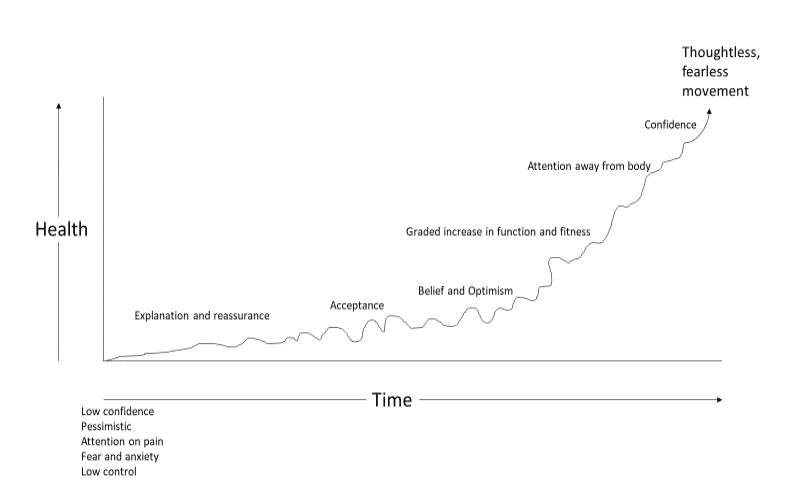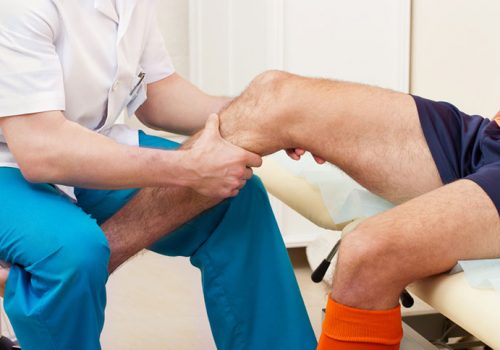
Look at the graph below – let’s call it the recovery graph. The vertical axis is health – meaning the higher up you go on the vertical axis the more your health improves. This may or may not mean your pain goes down. The bottom axis is time. As time goes on there is a progression upwards. This progression may be very variable and slow at the start. This phase of recovery is extremely hard to predict as it may move quite quickly for some and very slowly for others. It may be a constant gradual improvement for some and very variable for others. In my experience, the topsy turvy, up and down nature is quite common for most people. My advice here is always to ‘start-easy-build slowly’. Sometimes if we do too much too quickly it can lead to bigger flare ups, more frustration and giving up.

Look at the start of the graph. Most people at this stage report some feelings described in this section – ‘low in confidence’, ‘pessimistic with regards their prognosis’, ‘the pain is always on their mind’, ‘fear and anxiety’, ‘low control of their pain’. One word to sum it up might be vulnerable.
Explanation and Reassurance:
Understanding your pain is one of the most important first steps for anyone when managing an injury. What stage of healing am I at? Am I okay to start moving? Can I load my tissues? Is there something serious wrong? Any questions you may have need to be answered to your satisfaction. Knowledge is power. Or in this case it might be knowledge is avoiding activation of your threat centres.
Acceptance:
This is another big one to reduce the activity of the threat processing centres. This does not mean accept that your current circumstances will be forever. It means accepting that your current circumstance are your circumstances for now. Try not to think back too much to what you used to be able to do and can’t do now. If you can come to terms with your current situation and accept where you are at right now it can be a huge help in avoiding activation of your threat centres. I like to follow a Kaizen approach here – small and incremental improvements are the goal. Step by step progress. Recognise small goal achievements. Another way of looking at acceptance would be to stop fighting your pain, try to make friends with it. Try to look at it with curiosity, find out about it and explore ways of moving and doing without activation of your threat centres. This may sound crazy and telling you to make friends with your pain might make you want to scream, but if you stop fighting it, you stop processing it in the threat control centres. Obviously, some levels of pain might be so nasty that this is impossible, but lower levels of pain can be accepted sometimes, and this may help.
Belief and Optimism:
When you start to achieve a little success or achieve some small goals, you should reflect on this in a positive manner. Taking one small step leads to another small step and so on. You don’t climb to the top of a ladder in one step, it takes several small steps. Build your wall one brick at a time. This is the Kaizen approach (I will discuss Kaizen in a future writing). The important part here is that you see it and acknowledge it and view it in a positive way.
Graded increase in function and fitness:
If you have had pain for a long time it may well be that your fitness levels are relatively low. This may be because your pain may have stopped you from moving as much as normally, and you may have become generally unfit. The muscles and joints may be weaker and stiffer; hence they would be more vulnerable to further injury and become more sensitive. This is a hard step to navigate. Your body may require movement and exercise to get better, but this may hurt and cause a flare up. However, with good guidance, looking at your movements in a bit more detail, we should be able to find many ways of moving and exercising in a relatively comfortable way. Importantly. This would be in a way that you are happy and confident with. We would find a ‘baseline’ level of movement and exercise and gradually build from that baseline.
Attention away from body:
If you have had pain for a long time it may well be that you are constantly thinking about your pain when moving. Even if it is just an acute pain you might have similar thought processes around your movement and function. Moving around without giving it a thought, picking things up, do your work, exercising on automatic. This is a great goal to achieve This usually happens spontaneously as you improve but it is important to acknowledge when you notice that you are again doing things without thinking.
Confidence:
At the top of the curve there are generally four things that happen’
- You get control of your life back.
- Pain is usually far less of a problem. I would say here that to try not to let the pain level be the only way that you judge progress. This is very hard but confidence, function and activities are a much better judge of progress than level of pain
- Return of confidence with more positivity and optimism.
- Thoughtless-fearless-movement.















